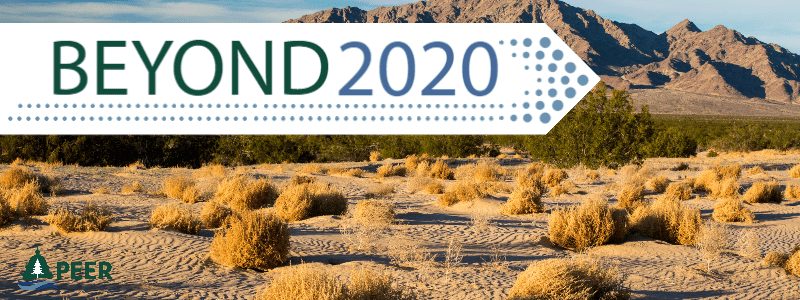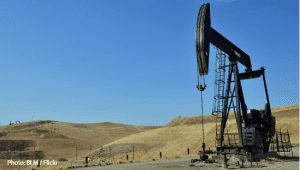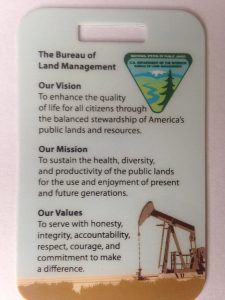
Overview
Founded in 1946 through a merging of the General Land Office with the US Grazing Service, the U.S. Bureau of Land Management (BLM) controls more than 247 million acres of public land, one-eighth of the country’s landmass.
Yet, as it approaches its 75th anniversary, few would argue that BLM is entering its golden age. Without a confirmed director for the past four years, BLM is now headed, on an unofficial basis,1 by a self-described “Sagebrush Rebel” who has devoted his career to divesting federal lands and impeding the very mission of BLM. With its Washington DC headquarters relocated, many senior staff have declined mandatory transfers to a new headquarters located in Grand Junction, Colorado, in a building shared with an oil and gas association.
The resulting brain-drain, loss of institutional knowledge, and marginalization have left the agency less capable than at any time within memory. Turning this sorry state of affairs around will require visionary new leadership driven by an awareness of the need for a sea change in BLM’s direction.
Seven Steps for Putting Management Back in BLM
In a July 2020 op-ed entitled “Bureau of Lost Management,”2 Jim Kenna, a retired BLM state director with 40 years of experience, decried the current orientation of BLM. He declared that the current agency actions directly conflict with BLM’s mission, writing:
“It is disappointing to see today’s leadership devaluing iconic landscapes, diminishing public participation, and catering to the financial ambitions of narrow, favored interests.”
We hear Mr. Kenna’s disappointment echoed daily by current and former BLM employees. These agency veterans’ recommendations for reform can be distilled into seven steps, each of which are interrelated and whose effects are mutually reinforcing.
1. Make Climate Change a Priority
Make Climate Change a Priority
Shortly after Interior Secretary David Bernhardt was confirmed, he stated that he does not consider it his job to combat climate change. While admitting that humans contribute to climate change, he contended that, by law, his job is to maximize energy development, not to minimize carbon emissions.3
As a matter of both fact and law, Bernhardt is wrong.
The principal statute governing BLM and Interior land management is the Federal Land Policy and Management Act (FLPMA) of 1976. While it describes BLM as an agency with a “multiple use” mandate, it makes clear that BLM must balance extractive uses with “ecological, environmental, air and atmospheric” values, and “where appropriate, will preserve and protect certain public lands in their natural condition.”4
At the same time, evidence is mounting about the key role federal land management plays in our carbon footprint. A recent United States Geological Survey study found that federally owned land is responsible for the equivalent of 1.3 billion metric tons of carbon dioxide released into the atmosphere, contributing 23 percent of the entire nation’s carbon dioxide emissions.5

Thawing permafrost on federal land / NPS Photo
Another study, published in the Proceedings of the National Academy of Sciences in 2017, concluded that “natural climate solutions” could provide up to a third of all the actions needed between now and 2030 to keep global temperatures within 2 degrees Celsius of their preindustrial levels. “Natural climate solutions” are defined as conservation, restoration, and improved land management actions that increase carbon storage and/or avoid greenhouse gas emissions across global forests, wetlands, grasslands, and agricultural lands.6
In short, a coherent U.S. policy to counter climate change must involve BLM, the custodian of the majority of federal lands.
Consider BLM’s vast commercial livestock program, for example. BLM oversees 21,000 grazing allotments covering 155 million acres of federal rangelands spread across 11 Western states. However, most all BLM grazing environmental assessments make no mention of climate change whatsoever, while the remainder say that impacts are unknowable and therefore will not be analyzed.7 These assessments should acknowledge grazing’s climate impacts, such as:
-
- Grazing dramatically reduces soil sequestration of carbon, releasing an estimated 11 million additional tons of carbon annually;
- The livestock sector generates more than one third of all human-induced methane, which is a gas with global warming potential 25 times that of carbon dioxide; and
- Public lands grazing is the most significant contributor to change in landscape conditions across a vast area of the American West, worsening adverse climate impacts of spreading desertification, degrading vital riparian areas and facilitating introduction of invasive species.8
These adverse effects are magnified if grazing is not well managed, and a large portion of allotments fails to meet BLM’s own range health standards (see below). These damaged landscapes create a feedback loop that further aggravates other negative impacts of climate change.
⇒ PEER recommends that BLM embrace mitigating climate effects as a central element of its mission. We will seek to ensure that all BLM planning includes assessments of climate impacts. Moreover, we will again press BLM to comply with Obama-era directives, which we expect will soon be revived, to mitigate climate effects and promote climate-resilient lands in all its programs.
2. Revive Planning, Inventory and NEPA
Revive Planning, Inventory and NEPA
Another eschewed BLM function is also one of its most basic: a continuing inventory of public lands. As FLPMA declares, the agency shall “prepare and maintain on a continuing basis an inventory of all public lands and their resource and other values…giving priority to areas of critical environmental concern. This inventory shall be kept current so as to reflect changes in conditions and to identify new and emerging resources and other values.”9
For the most part, BLM has abandoned its ongoing, frequently updated review of its land holdings as required by FLPMA. Nor does it systematically monitor changing conditions, such as climate change. PEER will urge the 117th Congress to require the BLM national inventory be updated as soon as practicable and to adopt a schedule for updates to ensure BLM is systemically monitoring changing conditions. These inventories must also be included in BLM planning efforts at the field level.
Another key element that has suffered of late in BLM planning is compliance with the National Environmental Policy Act (NEPA). NEPA requires agencies to “integrate the NEPA process with other planning at the earliest possible time,”10 thus ensuring that agencies conduct environmental analysis “before any irreversible and irretrievable commitment of resources” is made.11
Yet, BLM frequently does the opposite. The agency often engages in “retroactive NEPA” review, in which the BLM offices intentionally ignore environmental analysis requirements of NEPA, and in some instances has created NEPA documentation, including categorical exclusions and “determinations of NEPA adequacy,” after committing to a course of action. The office does not solicit public input or provide notice as required by the statute when it conducts such unlawful activities.12 Failure to comply with NEPA has resulted in a large and growing set of court reversals of BLM decisions to expand drilling, mining, and other extractive uses.13 These court rulings provide a roadmap for remedying BLM’s NEPA compliance.
⇒ PEER will identify BLM managers responsible for decisions invalidated for NEPA noncompliance and press incoming political leaders in Interior and BLM to hold these managers to account.
3. End the Oil Obsession
End the Oil Obsession
 To implement Trump’s “Energy Dominance” policy, BLM has made oil and gas permitting a major focus of its very limited resources. Despite an oil glut caused by overproduction and the COVID-19 pandemic, BLM has issued new leases for 200,000 acres in the four states of Colorado, Wyoming, Nevada and Montana alone. Oil companies are still seeking to open an additional 42 million acres through new area plans covering nine Western states and Alaska. These new drilling permits would add to the estimated 10,000-backlog of unused permits.
To implement Trump’s “Energy Dominance” policy, BLM has made oil and gas permitting a major focus of its very limited resources. Despite an oil glut caused by overproduction and the COVID-19 pandemic, BLM has issued new leases for 200,000 acres in the four states of Colorado, Wyoming, Nevada and Montana alone. Oil companies are still seeking to open an additional 42 million acres through new area plans covering nine Western states and Alaska. These new drilling permits would add to the estimated 10,000-backlog of unused permits.
At the same time, the industry has succeeded in getting the Trump administration to roll back or suspend Obama-era regulations requiring monitoring and reduction of methane gas discharged into the atmosphere, most often by flaring excess gas.
This myopic fixation on petroleum has come at the expense of core BLM functions. As BLM veteran Stan Olmstead pointed out in his farewell message in October 2012, the agency’s singular “focus on commodities and economics” has come at the expense of environmental health, an outcome he calls “a serious mission departure.”14 He offered these pointed examples:
-
- BLM fails to protect sensitive wildlife by opening critical habitat to drilling.
- Plugging abandoned well sites has not been a priority. Thousands of oil & gas wells have not produced for more than 15 years and yet these sites remain un-reclaimed.15
- Cumulative impacts from oil and gas drilling have been ignored, especially loss of forage for both wildlife and livestock.
Even when it tries to balance oil drilling with other uses, under Trump those other uses are often overturned. In one recent extreme instance, BLM HQ overruled its field managers to throw open nearly a million acres in southwest Colorado to oil and gas leasing. BLM records which PEER obtained through FOIA show that DC-based appointees told Colorado BLM managers that their more limited alternative “misses the mark” and was “not in line with the Administration’s direction to decrease regulatory burden and increase access. Further, proposed oil and gas extraction stipulations are too restrictive.”16 This HQ overrule violated a memorandum of understanding for joint planning with state and local officials and ran counter to strenuous objections from Colorado Governor Jared Polis and three county commissions.
⇒ PEER will urge the new BLM administration to impose a moratorium on new drilling permits until:
- The current backlog of unused permits has abated;
- The relevant district has completed an inventory of all abandoned or non-producing wells; and
- Has finalized recovery plans for all of these “orphaned” sites. In addition, strict new methane controls need to be imposed on all federal lands.
A final issue in this regard is the looming challenge of the over 40-year-old Trans-Alaska Pipeline System (TAPS). TAPS is one of the world’s largest pipeline systems, consisting of an 800-mile crude oil pipeline, with 11 pump stations, and several hundred miles of corrosion-plagued feeder pipelines, stretching across hundreds of miles of harsh terrain from the North Slope to Valdez Marine Terminal. It is operated by a consortium of oil companies under the oversight of BLM.
TAPS now moves only a quarter of the volume it carried at its peak. This reduced flow causes the crude to move slower, lose more heat, and gum up the system in myriad ways, creating ever more complex and expensive engineering problems. Yet even as the end of TAPS’s effective life looms, BLM has taken no steps to plan for the legally required dismantling and removal of TAPS facilities and restoration of the land utilized by pipeline facilities.17
⇒ PEER will be pressing BLM to abandon its posture of an absentee landlord in order to begin confronting the growing challenges facing one of the most complex delivery systems on the planet.[/box]
4. Reform the Grazing Program
Reform the Grazing Program
 Under FLPMA, no grazing permit may be renewed without a NEPA review if the allotment is not meeting landscape health standards due to grazing,18 but BLM is widely ignoring that legal requirement.
Under FLPMA, no grazing permit may be renewed without a NEPA review if the allotment is not meeting landscape health standards due to grazing,18 but BLM is widely ignoring that legal requirement.
BLM’s most recent data on the health of federal rangelands reveal extensive damage from excessive commercial livestock grazing. BLM’s Standards for Rangeland Health prescribe the minimum quality of water, vegetation and soils, as well as the ability to support wildlife, required by the agency for permitting livestock grazing. The most recent (2018) rangeland health report on BLM grazing allotments across 150 million acres in 13 Western states19 shows:
-
- Of total acres assessed, 42% fail to meet BLM Standards for Rangeland Health, totaling nearly 40 million acres, approximately the area of Washington State;
- The largest portion (70%) of range health failure is due to livestock overgrazing in allotments covering nearly 28 million acres, an area the size of Pennsylvania; and
- These figures are underestimates because nearly 40% of these federal rangelands – nearly 59 million acres or an area about the size of Oregon – have never been assessed.
At the same time, BLM has done no NEPA reviews during the past two fiscal years. In addition, approximately half of all BLM grazing permits are in an “unprocessed” status, meaning that the permits have been extended indefinitely with no environmental review at all. This backlog has been steadily growing through the past decade.20
In addition to the grazing which BLM permits on federal lands, there is a large amount of illegal or unpermitted grazing, a practice called “grazing trespass.” Records PEER obtained under a FOIA lawsuit show that BLM has dropped efforts toward long-promised reforms to stem illegal grazing.21 Documents produced by the suit also indicate BLM does not track the hundreds of grazing trespasses which occur each year, let alone assess the damage done by illegal grazing to range vegetation, soil and waters.
In short, BLM’s livestock grazing program is a vast zone of malign neglect. The challenge will be ensuring that BLM will actually start to enforce the law and its own regulations after so many years of ignoring deteriorating conditions. The key to overcoming this challenge will be instilling a new-found focus on landscape health.
At the outset of the Clinton administration, BLM undertook a meaningful “Range Reform” initiative that was aborted by the “Gingrich Revolution” elections of 1994. It is high time that stalled effort be re-started and augmented with additional efforts geared toward transparency.
⇒ Enforce the requirement that no commercial grazing permit be renewed if an allotment is failing to meet BLM’s Standards for Rangeland Heath due to overgrazing, absent a full NEPA review and a commitment to meet those standards after two years;
⇒ Adopt the Government Accountability Office recommendations to curb grazing trespass; and
⇒ Phase out grazing permits in desert areas and other areas where grazing significantly aggravates the adverse impacts of climate change.
⇒ Make records of the results of most recent Landscape Health Assessments for all grazing allotments publicly accessible on the BLM’s website. These records should contain data for every allotment’s permittee, acreage, NEPA status, Rangeland Health Status, and reason for that status, and should be linked to a queriable, searchable geospatial platform. PEER currently maintains such a database.22
5. Recover the Conservation Mandate
Recover the Conservation Mandate
 Trump appointees have required BLM staff to wear “Vision Cards” on their uniforms, which display the image of an oil rig and what appears to be livestock grazing,23 in contrast to the official BLM logo that shows a tree, a river and a mountain.
Trump appointees have required BLM staff to wear “Vision Cards” on their uniforms, which display the image of an oil rig and what appears to be livestock grazing,23 in contrast to the official BLM logo that shows a tree, a river and a mountain.
These Vision Cards reference serving “stakeholders” and “customers” but do not mention serving the public. They further declare that the purpose of improving “the health and productivity of the land” is “to support the BLM multiple-use mission,” statements that demonstrate how far BLM has strayed from protecting lands for wildlife habitat and for core environmental health.
The BLM manages a vast series of national monuments, national preservation areas, wilderness study areas, wild and scenic rivers and trails covering nearly 35 million acres, all in a system called National Conservation Lands.24 While these lands are supposed to be managed primarily for conservation, BLM has inserted extractive uses into management plans, opened some portions to off-road vehicles and ended the periodic surveys of these lands required by the Wilderness Act (see above). For example, BLM has not reassessed the 15.5 million acres it manages in wilderness study areas to determine whether any portion should be recommended for Congressional designation as wilderness.
In addition, BLM has been delinquent in compiling statutorily required reports about the impact of its permitted uses on federally listed threatened and endangered species to the Fish and Wildlife Service annually. BLM is supposed to develop monitoring protocols that track effects of activities like off-road vehicle use and grazing on endangered and threatened species like the desert tortoise, Peninsular bighorn sheep and Lane Mountain milk vetch. Without the required monitoring and reporting, neither agency can know how many threatened and endangered species are being harmed by various activities or what steps might be taken to reduce that harm.
Enforcement of these requirements has required lawsuits from conservation organizations, yet these suits are sporadic and species-specific.25 BLM must commit itself to compliance with its Endangered Species Act responsibilities across the board.
At the same time, the Trump decision to shrink national monuments has opened previously protected lands to commercial uses. Reversing those Trump decisions whether by judicial order or a new presidential declaration will be a top priority.
⇒ For its network of Conservation Lands, PEER will pressure BLM to abandon its multiple-use approach and instead look to adopt policies practiced by the National Park Service to return conservation to the forefront of its management practices.
6. Rein in Destructive Recreation
Rein in Destructive Recreation

Destruction from Off Road Vehicles
Off-road vehicle abuse is a growing problem on BLM and other public lands as overuse by vehicles and reckless riders tears up fragile lands and streams and damages ecosystems.26
Reckless off-roading is creating a backlash among many public land users, including those who enjoy viewing wildlife, conducting archaeological research, hiking, camping and hunting. Besides causing extensive damage to natural and cultural resources, off-road vehicles are becoming an increasingly severe public safety and law enforcement problem, and taxpayers will be stuck with the bill to clean up their mess.27 Yet, despite worsening off-roading problems, BLM still lacks a coherent plan to manage the influx of off-road vehicles on public lands.
PEER has been working with overstretched state and federal land managers to develop a strategy to cope with the burgeoning safety and environmental havoc wreaked by an explosion in off-road vehicle use and abuse on our public lands. This strategy includes:
⇒ Deterrent penalties: Today’s infraction fines for off-road abuse are inadequate. Reckless off-roading should be punished by loss of hunting and fishing licenses as well as confiscation of vehicles when off-roaders are caught destroying property or ignoring the law, just as we confiscate weapons when people are caught poaching. Repeat offenders should face suspension of riding privileges and fishing and hunting licenses and, where appropriate, jail time.
⇒ Tough enforcement: Enforcement against off-road abuse is taking an ever-larger toll on overstretched rangers. Off-roading is fast becoming the number one law enforcement problem on our public lands. Congress and state legislatures need to immediately augment their affected public lands law enforcement budgets. In addition, they should also empower other public lands agency officials to issue citations.
⇒ End hidden costs to taxpayers: Taxpayers are footing the bill for the damage caused by reckless off-roaders. As yet, we do not know the full extent of these costs. Congress needs to conduct a thorough investigation and enact common sense solutions to the growing off-road problem
Another aspect of this problem is BLM’s increasing neglect of cultural resources most at risk from open-range off-roading. Consider the experience of Stacey Antilla, a BLM Outdoor Recreation Planner at the southern Nevada BLM station, who resigned in frustration after failing in her efforts to properly plan and mitigate the damage resulting from the thousand-mile “Vegas-to-Reno” off-road vehicle race across endangered desert tortoise habitat in the Mojave and Great Basin Deserts. The BLM Tonopah manager refused to address documented problems from past races and ignored violations of agency policy, permit stipulations and resource law, including:
-
- Routing the race through sensitive desert areas rather than keeping the course on established roads;
- Allowing heavy equipment into a desert river that is habitat to endangered species; and
- Refusing to survey and correct post-race damage.28
⇒ PEER plans to reach out to current and former cultural resource staff to determine how best to monitor compliance with its mandate to protect cultural and archaeological resources.
A final area of concern with BLM’s recreation management is public and employee health from high levels of lead on recreational shooting ranges. Interior’s Office of Inspector General issued a report this year on the problems, following employee revelations channeled through PEER,29 that recommended BLM warn the public and their own employees about lead exposure risks and clean up the contamination. To date, BLM has done neither.
⇒ PEER will press BLM to finally implement the IG recommendations.
7. Resurrect Law Enforcement
Resurrect Law Enforcement

BLM Photo / Flickr
BLM manages the most public lands of any agency and is responsible for protecting resources and visitors across those acres, but it employs fewer rangers than it did five years ago. One effect of this decline appears to be that the number of criminal environmental cases coming out of BLM and other Interior agencies has fallen by half since 2016 to a more than 20-year low and last year saw the lowest number of new prosecutions since 1995.
BLM’s law enforcement represents only around 3% of agency staff, which has also been shrinking in recent years. The latest figures released by BLM under the Freedom of Information Act show only 202 rangers on the law enforcement beat during 2017. That number, while a small uptick from the past three years, is below the 224 rangers on patrol in 2012. In addition, of the 254 authorized ranger positions, fully a quarter remain unfilled.30
With an estimated 70 million recreational visits this year, each BLM law enforcement ranger is now tasked with safeguarding an area approaching the size of Delaware with some 35,000 average annual recreational visitors. BLM rangers are charged with investigating or deterring a wide range of resource offenses, including wildland arson, hazardous materials dumping and archaeological artifact theft, among other matters, in addition undertaking search and rescue operations.
In addition to law enforcement rangers, BLM currently deploys 70 special agents, used primarily as detective-level criminal investigators, representing the same agent force level that BLM had 25 years prior in 1992. Significantly, one fifth of the authorized agent slots remain vacant.
At the same time, more BLM conservation lands are being opened for multiple uses as President Trump shrinks national monuments. Meanwhile, BLM’s border responsibilities are expanding as rangers and special agents are re-assigned to assist the U.S. Border Patrol outside of BLM areas. BLM already manages nearly 200 miles of lands directly along the Mexico border.
In short, BLM law enforcement rangers patrol a significant portion of the country’s land area with a force smaller than those of many mid-sized cities. There are simply not enough rangers to do the job effectively, and many rangers in the existing workforce are absent from their assigned patrol areas for weeks at a time due to frequent border and drug enforcement details. One effect appears to be fewer criminal cases relating to Interior resource protection brought and prosecuted in a generation, according to Justice Department figures compiled by PEER.
This staffing shortfall is compounded by a hostile agency leadership. William Pendley, an unconfirmed BLM Deputy Director who claims to be “exercising the authority of the Director,” states that BLM law enforcement rangers should defer to local sheriffs regarding violations of federal law on BLM land.31Pendley’s contention that “local law enforcement bears primary responsibility for enforcing state and federal law” on BLM law is not rooted in any statute or regulation and appears to fly in the face of more than a century of constitutional case law surrounding federal supremacy. Moreover, federal laws are exactly what BLM’s rangers are specially trained and tasked to enforce.
Pendley’s radical position also threatens to aggravate flashpoints leading to needless and potentially violent confrontation. For example, BLM Management Plans call for road closures to protect vulnerable resources, such as archaeological sites and critical habitat for endangered species. As we have seen in some counties, local officials, including sheriffs, oppose these closures.
This concern is not abstract. Experiences with the renegade rancher Cliven Bundy and the seizure of the Malheur National Wildlife Refuge illustrate how dangerous these conflicts over federal lands management can become.
A recent study published in the peer-reviewed journal, Political Behavior, looked at so-called “Constitutionalist” sheriffs in four Utah counties who claim federal authority is subordinate to them. The study found “Counties with constitutionalist sheriffs are 50% more likely to have violence against BLM employees than other counties, even when controlling for other factors.” It concluded that these sheriffs “increase political violence against the federal government by stoking citizens’ anti-federal grievances and by making it difficult for the BLM employees to enforce land regulations.”32
The public perception of BLM law enforcement also reflects these realities. In a PEER survey of BLM staff in nine Western states, nearly half of respondents reported “threats to our safety due to resource management issues.” Significant percentages of BLM staff also do not “feel safe when I am in the field.”33
⇒ PEER will advocate for the appointment (and confirmation) of a BLM Director who believes in the agency’s law enforcement mission. That Director should, in turn:
- Appoint experienced and professional leadership to revive BLM’s law enforcement program;
- Raise law enforcement staff levels to 5% of current workforce (from the present 3%); and
- Develop work plans that prioritize resource and visitor protection, as opposed to peripheral assignments, such as border patrols.
Conclusion
Conclusion
The good news about the current state of the BLM is that the potential for positive impact is far greater than with any other federal land management agency. For example, given the small size of the BLM law enforcement program, even a small increment of additional resources and focused management commitment could make a huge difference.
The key change, toward which PEER will focus much of our energy, will be a new leadership direction to engender policies designed to conserve the resources within these vast lands and to place America’s long-term interest in this irreplaceable public lands heritage above short-term profits.
.
References
Footnotes
For footnotes cited in document, see the print version of the paper available here.
 Jeff Ruch is the Director of PEER’s Pacific office, having formerly served 22 years as the Executive Director of PEER.
Jeff Ruch is the Director of PEER’s Pacific office, having formerly served 22 years as the Executive Director of PEER.
 Tim Whitehouse is the Executive Director of PEER and formerly served as an attorney for the EPA.
Tim Whitehouse is the Executive Director of PEER and formerly served as an attorney for the EPA.

